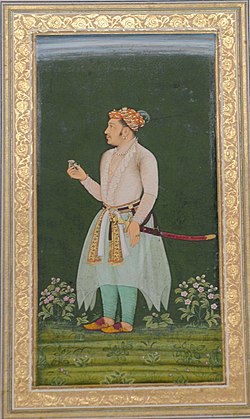Dawar Bakhsh
| Dawar Bakhsh | |||||
|---|---|---|---|---|---|
 | |||||
| Mughal Emperor (de facto) | |||||
| Reign | 28 October 1627 – 23 January 1628 /Co-Ruler - Sharyar | ||||
| Predecessor | Jahangir | ||||
| Successor | Shah Jahan | ||||
| Born | c. 1607 | ||||
| Died | 23 January 1628 (aged 20–21) Lahore, Mughal Empire | ||||
| Spouse | Sister of Raja Jai Singh of Amber[1] | ||||
| |||||
| Dynasty | Timurid | ||||
| Father | Khusrau Mirza | ||||
| Mother | Daughter of Mirza Aziz Koka | ||||
| Religion | Islam | ||||
Dawar Bakhsh (Persian: داور بخش; died 23 January 1628), which means "God Given", was the ruler of the Mughal Empire for a short time between 1627–1628, immediately after the death of his grandfather Jahangir (r. 1605–1627).
Dawar was the child of Jahangir's eldest son, Prince Khusuru, who was killed at the behest of Prince Khurram (Shah Jahan) in 1622.[2]
Dawar, who was affectionately nicknamed "Bulaqi" (meaning "Nose-ring"),[3] was initially named the Diwan of the Dakhin, and later Governor of Gujarat in 1622 by his grandfather, Jahangir.[4][5][6] However, being only fifteen years old at this point, the prince was placed under the guardianship of his maternal grandfather, Mirza Aziz Koka.[7] The Emperor also arranged Dawar's marriage in 1625 to his cousin, the sister of Jai Singh of Amber to ensure the Raja's loyalty.[1]
Upon the death of his grandfather, he became a pawn in the political game to seize the Mughal throne. He was declared the Mughal Emperor by Asaf Khan as a stopgap arrangement to counter the claims of the queen Nur Jahan, who wanted Shahryar to succeed.
Dawar's ascension and death[edit]
Upon the death of Jahangir, in order to secure the accession of Shah Jahan, Asaf Khan, the brother of Nur Jehan, brought Dawar Baksh out of confinement, declared him king and sent him to Lahore.
However, Nur Jahan favoured Jahangir's youngest son, Shahriyar, to ascend, and since he was in Lahore at the time, he ascended to the throne, captured state treasury and, in an attempt to secure his throne, distributed over 70 lakh rupees amongst old and new noblemen. Meanwhile, Mirza Baisinghar, son of the late Prince Daniyal, on the death of the Emperor, fled to Lahore, and joined Shahryar.
The two forces met near Lahore. Shahryar lost the battle and fled into the fort, where the next morning he was presented in front of Dawar Baksh, who placed him in confinement.
On Jumada-l awwal 2, 1037 AH (30 December 1627[8]) Shah Jahan was proclaimed Emperor at Lahore, and on Jumada-l awwal 26, 1037 AH (23 January 1628[8]) on his orders, Dawar, his brother Garshásp, Shahryar, and Tahmuras and Hoshang, sons of the deceased Prince Daniyal, were all put to death.[9]
However, there are some suggestions that Dawar had managed to avoid this fate and escaped to Persia. As late as 1633, ambassadors from the Duchy of Holstein claimed to have encountered him there, and the French glassmaker Tavernier went so far as to state that he had conversed and dined with the prince.[3]
Ancestry[edit]
| Ancestors of Dawar Bakhsh | ||||||||||||||||||||||||||||||||||||||||||||||||||||||||||||||||||||||||||||||||||||||||||||||||||||||||||||||||||||||||||||||||||||||||||||||||||||||||||||||||||||||||||||||||||||||||||||||||||||||||||||||||||||||||||||||||||||||
|---|---|---|---|---|---|---|---|---|---|---|---|---|---|---|---|---|---|---|---|---|---|---|---|---|---|---|---|---|---|---|---|---|---|---|---|---|---|---|---|---|---|---|---|---|---|---|---|---|---|---|---|---|---|---|---|---|---|---|---|---|---|---|---|---|---|---|---|---|---|---|---|---|---|---|---|---|---|---|---|---|---|---|---|---|---|---|---|---|---|---|---|---|---|---|---|---|---|---|---|---|---|---|---|---|---|---|---|---|---|---|---|---|---|---|---|---|---|---|---|---|---|---|---|---|---|---|---|---|---|---|---|---|---|---|---|---|---|---|---|---|---|---|---|---|---|---|---|---|---|---|---|---|---|---|---|---|---|---|---|---|---|---|---|---|---|---|---|---|---|---|---|---|---|---|---|---|---|---|---|---|---|---|---|---|---|---|---|---|---|---|---|---|---|---|---|---|---|---|---|---|---|---|---|---|---|---|---|---|---|---|---|---|---|---|---|---|---|---|---|---|---|---|---|---|---|---|---|---|---|---|
| ||||||||||||||||||||||||||||||||||||||||||||||||||||||||||||||||||||||||||||||||||||||||||||||||||||||||||||||||||||||||||||||||||||||||||||||||||||||||||||||||||||||||||||||||||||||||||||||||||||||||||||||||||||||||||||||||||||||
References[edit]
- ↑ 1.0 1.1 Inayat ali Zaidi, The Rajput chiefs and Prince Shah Jahan revolted (1987), p. 74
- ↑ Ellison Banks Findly (25 March 1993). Nur Jahan: Empress of Mughal India. Oxford University Press. pp. 170–172. ISBN 978-0-19-536060-8.
- ↑ 3.0 3.1 Waldemar Hansen, The Peacock Throne: The Drama of Mogul India (1986), p.85-6
- ↑ Khusrau Tuzk-e-Jahangiri, The Memoirs of Jahangir (Rogers), Volume 2, chpt. 52 "... To Dawar-bakhsh, s. Khusrau, I gave the mansab of 5,000 personal and 2,000 horse."
- ↑ Commanders of Three Hundred. Ain-i-Akbari, by Abul Fazl, chpt. 234.
- ↑ On the first of the Divine month of Khurdād Prince Dāwar-bakhsh, s. Khusrau, was appointed to Gujarat Tuzk-e-Jahangiri, The Memoirs of Jahangir (Rogers), Volume 2, chpt. 56.
- ↑ 7.0 7.1 Dr S. B. Rajyagor, Gujarat State Gazetteers: Ahmadabad District Gazetteer (1984), p. 89
- ↑ 8.0 8.1 Taylor, G.P.(1907). Some Dates Relating to the Mughal Emperors of India in Journal and Proceedings of the Asiatic Society of Bengal, New Series, Vol.3, Calcutta: The Asiatic Society of Bengal, p.59
- ↑ Death of the Emperor (Jahangir) Archived 9 February 2012 at the Wayback Machine The History of India, as Told by Its Own Historians. The Muhammadan Period, Sir H. M. Elliot, London, 1867–1877, vol 6.
- ↑ Findly (1993, pp. 170–2)
- ↑ 11.0 11.1 Catherine Ella Blanshard Asher, Architecture of Mughal India (1992), p. 104
- ↑ Jahangir (1909–1914). The Tūzuk-i-Jahangīrī Or Memoirs Of Jahāngīr. Translated by Alexander Rogers; Henry Beveridge. London: Royal Asiatic Society. p. 1. Archived from the original on 5 March 2016. Retrieved 19 November 2017.
- ↑ Jahangir et al. & 1909-14, p. 1)
- ↑ Malika Mohammada, The Foundations of the Composite Culture in India (2007), p. 300
- ↑ 15.0 15.1 Jahangir et al. & 1909-14, p. 458)